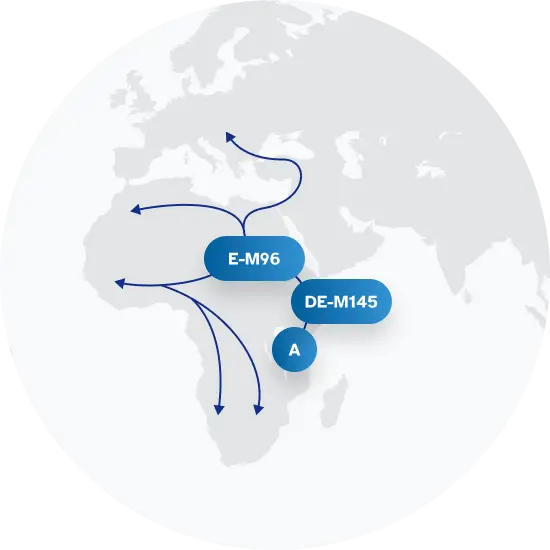Explore the Family Name Driggers
How common is the last name Driggers in the United States?
Based on the Decennial U.S. Census, the surname Driggers saw a shift in its popularity between the years 2000 and 2010. In the year 2000, it was ranked 4510th in terms of frequency but slipped to the 4648th spot in 2010, marking a decrease of 3.06% in its rank. However, the actual count of individuals with this surname increased by 5.49%, from 7243 to 7641 during this decade. The proportion per 100k of the population also experienced a slight decrease, falling from 2.68 to 2.59.
| 2000 | 2010 | Change | |
|---|---|---|---|
| Rank | #4,510 | #4,648 | -3.06% |
| Count | 7,243 | 7,641 | 5.49% |
| Proportion per 100k | 2.68 | 2.59 | -3.36% |
Race and Ethnicity of people with the last name Driggers
When looking at the ethnic identity associated with the surname Driggers as per the Decennial U.S. Census, there were some notable changes observed between 2000 and 2010. The largest group identifying with this surname continued to be White, though the percentage did decrease slightly from 93.88% to 92.61%. The Hispanic percentage increased significantly by 52.48%, growing from 1.41% in 2000 to 2.15% in 2010. Those identifying as Asian/Pacific Islander and those indicating two or more races also saw increases, with the latter group experiencing the most significant jump of 50.81%. The Black community saw a decrease of 10.27%, while the American Indian and Alaskan Native group remained relatively stable with a minor increase of 0.63%.
| 2000 | 2010 | Change | |
|---|---|---|---|
| White | 93.88% | 92.61% | -1.35% |
| Hispanic | 1.41% | 2.15% | 52.48% |
| Two or More Races | 1.24% | 1.87% | 50.81% |
| American Indian and Alaskan Native | 1.59% | 1.6% | 0.63% |
| Black | 1.46% | 1.31% | -10.27% |
| Asian/Pacific Islander | 0.41% | 0.47% | 14.63% |
Driggers ancestry composition
23andMe computes an ancestry breakdown for each customer. People may have ancestry from just one population or they may have ancestry from several populations. The most commonly-observed ancestry found in people with the surname Driggers is British & Irish, which comprises 68.8% of all ancestry found in people with the surname. The next two most common ancestries are French & German (18.5%) and Italian (2.5%). Additional ancestries include Scandinavian, Eastern European, Spanish & Portuguese, Korean, and Indigenous American.
Ready to learn more about your ancestry? Get the most comprehensive ancestry breakdown on the market by taking our DNA test. Shop 23andMe
| ANCESTRY BREAKDOWN | COMPOSITION |
|---|---|
| British & Irish | 68.8% |
| French & German | 18.5% |
| Italian | 2.5% |
| Other | 10.2% |

Possible origins of the surname Driggers
Your DNA provides clues about where your recent ancestors may have lived. Having many distant relatives in the same location suggests that you may all share common ancestry there. Locations with many distant relatives can also be places where people have migrated recently, such as large cities. If a large number of individuals who share your surname have distant relatives in a specific area, it could indicate a connection between your surname and that location, stemming from either recent ancestral ties or migration.
Based on 23andMe data, people with last name Driggers have recent ancestry locations all within the United Kingdom of Great Britain and Northern Ireland.
| RECENT ANCESTRY Location | Percentage |
|---|---|
| West Yorkshire, United Kingdom | 95.00% |
| Belfast, United Kingdom | 95.00% |
| Glasgow City, United Kingdom | 95.00% |
| Lancashire, United Kingdom | 95.00% |
| South Yorkshire, United Kingdom | 93.60% |
What Driggers haplogroups can tell you
Haplogroups are genetic population groups that share a common ancestor on either your paternal or maternal line. These paternal and maternal haplogroups shed light on your genetic ancestry and help tell the story of your family.
The top paternal haplogroup of people with the surname Driggers is E-CTS3380, which is predominantly found among people with Sub-Saharan African ancestry. Haplogroup E-CTS3380 is descended from haplogroup E-M96. Other common haplogroups include R-CTS241 and E-P179, which are predominantly found among people with European and European ancestry. Other surnames with similar common haplogroups are: Waterman, Hilbert, Simmonds, Slater, Peake, Shaw, Phillips, Howe, Morgan, Archer.
The most common maternal haplogroups of people with Driggers surname are: H1, K1a, H. These most commonly trace back to individuals of European ancestry.
 Paternal Haplogroup Origins E-M96
Paternal Haplogroup Origins E-M96
Your paternal lineage may be linked to some of the Fulani and Hausa people
If you have haplogroup E1a, your paternal line stems from a branch of haplogroup E called E-M132, which is seen at low frequencies in the Bahamas on the islands of Abaco, Eleuthera, Exuma, Grand Bahama, and Long Island. This is likely a reflection of historical movements of African and Creole slaves before and after the abolition of slavery in 1807. Over 25% of slaves transported to the Bahamas during the slave trade were from West and Central Africa, which is consistent with the most common location of E-M132. Lower numbers of slaves were taken from other ports in Africa, including those along the Gold Coast, the Windward Coast, and the Bight of Biafra. Many African ethnic groups were victims of the Transatlantic Slave Trade, including the Fulani and Hausa, two groups in which haplogroup E1a are heavily represented.
Your maternal lineage may be linked to Marie Antoinette
Because it is so dominant in the general European population, haplogroup H also appears quite frequently in the continent's royal houses. Marie Antoinette, an Austrian Hapsburg who married into the French royal family, inherited the haplogroup from her maternal ancestors. So did Prince Philip, Duke of Edinburgh, whose recorded genealogy traces his female line to Bavaria. Scientists also discovered that famed 16th century astronomer Nicolaus Copernicus traced his maternal lineages to haplogroup H.

What do people with the surname Driggers have in common?
Spoiler alert: it's complicated. People with the same last name are usually no more genetically similar than a randomly sampled group of people from the same population. That said, people with the same surname are more likely to have similar ancestries than randomly sampled individuals. The reason is the tendency of people with similar cultural or geographical backgrounds to preferentially mate with one another. That's why people who share a surname may be more likely to share traits and tendencies in common than people within the general population. Check out the percentages below to see the prevalences of tastes, habits, and traits of people with your surname compared with prevalences among 23andMe users.
Preferences
Traits
Habits
Wellness

Migraine
A severe headache characterized by intense pain, sensitivity to light and sound, and often accompanied by nausea and vomiting.
"Driggers" Surname 22.3%
23andMe Users 16.4%
Are health conditions linked to the last name Driggers?
The short answer is that, if there is an association between surname and health, it's usually more about your ancestry than your name. Individuals with a given surname are no more genetically similar than the general population but often have similar ancestries. The populations of people associated with those shared ancestries often have sets of genetic variations, also known as alleles, in common. Some of those alleles are associated with a greater likelihood of developing certain diseases.
Disease variant frequency by ancestry
Disease allele frequencies in populations associated with the surname Driggers are shown below. Important Note: not everyone with a disease allele will develop these health condition

















